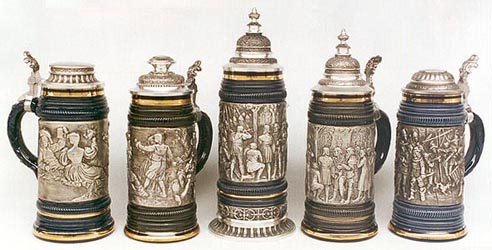
 |
Generally speaking, recent Thewalt production has been limited to traditional, hand-painted, relief stoneware steins aimed principally at the German tourist market. However, in 1992 the company began breaking new ground with a series of innovative and attractive “pewter-banded steins.” Starting with a “blank” stoneware body, Thewalt wraps it with one of a variety of antiqued, relief pewter “bands,” covering the majority of the stein’s surface. The result is a stein with an unmistakably German look and feel, but also with that “something extra” that clearly separates it from the ordinary.
There are currently ten different band designs in the series, several of which, as can be seen in Figure 1, may be had with a variety of different body and lid styles, not to mention two different stoneware colors (blue and black). Nine of the bands are sized for ½ liter steins and are being produced in limited editions of 5,000. The tenth band wraps around an impressive 2-liter stein, standing 15½ inches tall to the top of its finial, and has an edition limit of only 2,000. Suggested retail prices for the ½ liter steins range from about $115 to $225, depending principally on the selection of body and lid. The 2-liter stein will set you back about $375.00.
The complete series listing is as follows:
Jousting Stein (2 ltr.) — The biggest of these steins reproduces a design of 19th century steinmaker Reinhold Hanke. The pewter band shows knights on horseback jousting, while others compete on foot with swords and shields, all framing a gold-plated crown and eagle crest. A unique helmeted knight thumblift comes complete with a rotating faceguard. A pewter knight on horseback sits atop the pewter lid. At a suggested retail price of $375.00, this is a pretty pricey item, but as they say, you get what you pay for. (Figure 2)
Figure 2 Royalty Stein (½ ltr.) — A Peter Dümler design was used to create this stein, featuring a five-panel mural of King Charlemagne, his guards and his subjects. Eight insets of separately cast pewter lions and crowns circle the stein’s octagonal base. Although several different lids are available for this stein, the one most likely to be seen in the U.S. has a standing knight in armor finial. (Figure 3, left)
Rembrandt Stein: Nightwatch (½ ltr.) — The design of the pewter band on this stein was taken from Rembrandt’s well-known 1642 painting of a company of Dutch soldiers, popularly known as “The Nightwatch.” (Figure 1, right)
Figure 3 William Tell Stein (½ ltr.) — Here the pewter band provides a detailed recreation of the famous scene from the legend of Swiss hero William Tell, who was forced, on pain of death, to shoot an apple from his son’s head with a bow and arrow. (Figure 1, 3rd and 4th from left)
Biedermeier Stein (½ ltr.) — A traditional depiction of mid-19th century Germans drinking and dancing provides the subject-matter for this stein. But don’t look for it in your local stein shop. For the time being at least, it's not being imported into the United States. (Figure 1, 1st and 2nd from left)
Last Supper Stein (½ ltr.) — The universally recognized portrait of Jesus breaking bread with his twelve apostles was recreated in pewter relief for this stein. (Figure 3, right)
Lion Stein (½ ltr.) — On this stein, three separately cast, deep-relief pewter lion heads with rings in their mouths are attached to the pewter band. The lower border of the band is decorated with eagles, serpents and lions. Gracing the top of the stein is a winged pewter lion finial, complete with red glass eyes. (Figure 4, left)
Figure 4 Griffin Stein (½ ltr.) — Clearly designed as a mate to the Lion Stein, the Griffin Stein is identical in all respects, except that the lion is replaced by a griffin, that mythological creature with the body of a lion, but with the head and wings of an eagle. (Figure 4, right)
Angel Stein (½ ltr.) — Here the pewter band displays three panels of relief Seraphim angels. In addition, three separately cast pewter angels are mounted around the stein’s flared base. A pewter figurine representing the Archangel Michael serves as the finial, with gold-highlighted wings, sword and shield. (Figure 5, left)
Figure 5 Wedding Stein (½ ltr.) — The final and most recent stein in the series uses the same body as the Angel Stein, with its three pewter angels around a flared base. The pewter band has a central scene depicting a newlywed couple leaving the chapel, and side panels showing a flower girl and a ring bearer. A bride and groom finial completes the picture. (Figure 5, right)
Whether you’re thinking of adding to your own collection or searching for a unique gift, the pewter-banded steins from Thewalt are well worth a second look. From a gift-giving standpoint, the Wedding Stein presents obvious possibilities as a newlywed keepsake, and the Last Supper Stein might be just the ticket for a unique Christmas present. As a gift to yourself, these innovative drinking vessels, rendered with traditional German attention to quality and detail, would be equally at home in a collection of antique or modern beer steins.
__________
*Reprinted by permission from Prosit, the Journal of Stein Collectors International, Vol 2, No. 30, June 1999.